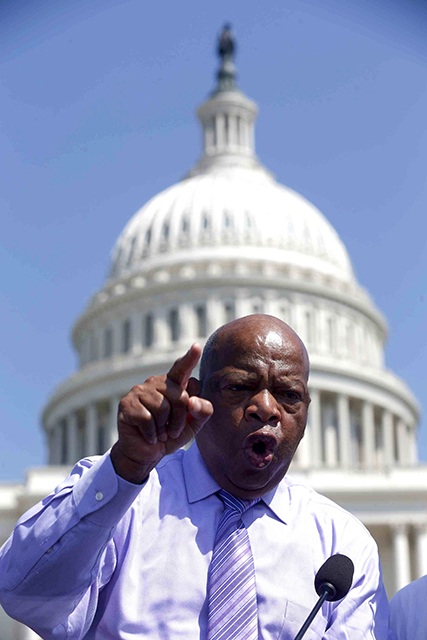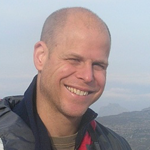We’re proud to collaborate with The Nation in sharing insightful journalism related to income inequality in America. The following is an excerpt from Nation contributor Greg Kaufmann’s “This Week in Poverty” column.

Rep. John Lewis, D-Ga. speaks at a rally for immigration reform on Capitol Hill in Washington, Wednesday, April 10, 2013. (AP Photo/Charles Dharapak)
“[African Americans] must march from the rat-infested, over-crowded ghettos to decent, wholesome, unrestricted residential areas disbursed throughout our cities…. They must march from the play areas in crowded and unsafe streets to the newly opened areas in the parks and recreational centers,” said Whitney Young Jr., executive director of the National Urban League.
When I read those words this week, I thought it sounded like a good recommendation for residents of my hometown, Washington, D.C., which has in essence been two separate and unequal cities since my great grandparents came here in the 1920s — and it remains so today.
But Young said this at the March on Washington for Jobs and Freedom in 1963, exactly fifty years ago on August 28. A new report from the Economic Policy Institute, The Unfinished March — An Overview, offers a compelling look at the economic vision that was laid out on that day and has since been forgotten. It also examines the continuing struggle to achieve that vision.
Most Americans associate the March with the Reverend Dr. Martin Luther King Jr.’s “I have a Dream Speech” and celebrate the victories of the civil rights movement that followed. But report author Algernon Austin, director of EPI’s Program on Race, Ethnicity and the Economy (PREE), writes that there were “nine other speeches that day” and that the march organizers called for “decent housing, adequate and integrated education, a federal jobs program for full employment, and a national minimum wage of over $13.00 an hour in today’s dollars.”
Where do we stand today in meeting those goals?
There are still ghettos of poverty that lack decent housing — where poor, minority children don’t have the same access to resource-rich, middle-class communities as poor, white children do. Nearly half of poor African-American children live in neighborhoods with concentrated poverty, defined as areas where 30 percent of the census tract population lives below the federal poverty threshold (on less than $18,000 for a family of three). In contrast, only 12 percent of poor white children live in neighborhoods with concentrated poverty. (39 percent of poor American-Indian children live in areas of concentrated poverty, as do 35 percent of poor Hispanic children and 21 percent of poor Asian and Pacific Islander children.)
Austin describes how concentrated poverty is correlated “with a host of social and economic challenges,” including: higher crime rates, higher exposure to lead, higher prevalence of alcohol and fast food outlets and fewer opportunities to be physically active due to crime and limited green space. All of these factors make the struggle to rise from poverty significantly harder.
Relatedly, Austin points to the call by speakers at the March “for black children to gain access to adequate and integrated education.”
“[We] must march from the congested ill-equipped schools, which breed dropouts, and which smother motivation, to the well-equipped integrated facilities throughout the cities,” argued Young at the March.
But today we have public schools that are essentially separate and unequal. 74 percent of African Americans still attend majority nonwhite schools, compared to just over 76 percent in the late 1960s. That number had dropped down to 63 percent by the early 1980s, but Austin suggests that progress reversed due to a “lack of commitment by the federal government and multiple decisions by the Supreme Court.” The share of black children in schools that are 90 to 100 percent nonwhite has also stagnated at around 38 percent since the early 2000s.
Why are these numbers so significant?
“…Now as a half century ago — segregated schools are unequal schools,” writes Austin. A 10 percent increase in a school’s nonwhite students is associated with a $75 decrease in per student spending. Furthermore, “the average school with 90 percent or more non-white students has $443,000 less to spend on students during the school year.” (Italics added.)
With this kind of stark difference in educational opportunities and resources, it’s hardly a surprise that — absent a full employment program that the March speakers called for — we have seen the black unemployment rate remain 2 to 2.5 times higher than the white unemployment rate from 1963 to 2012.
“Indeed, black America is nearly always facing an employment situation that would be labeled a particularly severe recession if it characterized the entire labor force,” notes Austin.
When the economy was booming in 2000, and the white unemployment rate was 3.1 percent, the black unemployment rate was still a recession-like 7.6 percent. In the aftermath of the recent Great Recession, when white unemployment peaked at 8 percent, black unemployment stood at a Depression-like 15.9 percent. (The average national unemployment rate from 1929 to 1939 was 13.1 percent.)
“If we can have full employment and full production for the negative ends of war then why can’t we have a job for every American in the pursuit of peace?” asked Walter Reuther, president of the United Automobile Workers of America, speaking at the March in 1963.
Austin asserts that unless we commit to a full employment policy that brings down the minority unemployment rates, “it will be impossible for blacks to have low poverty rates.” Indeed in 2011, the black poverty rate was 27.6 percent — nearly three times the white poverty rate of 9.8 percent that year, according to the most recent U.S. Census Bureau figures.
For African Americans who do find work, a disproportionate number are paid low wages. In 2006, 36 percent didn’t earn hourly wages sufficient to lift a family of four out of poverty (above approximately $23,000 annually); the same holds true for more than 43 percent of Hispanics, and nearly 25 percent of whites. In 2011, a worker needed to earn $11.06 an hour to lift a family of four out of poverty.
“We march today for jobs and freedom, but we have nothing to be proud of, for hundreds and thousands of our brothers are not here — for they are receiving starvation wages or no wages at all,” said John Lewis in 1963, then the national chairman for the Student Nonviolent Coordinating Committee, and now a U.S. congressman.
The marchers wanted the minimum wage to be lifted from $1.15 to $2 an hour — the equivalent of more than $13 an hour today. But it now stands at $7.25 and its inflation-adjusted value is about $2 less than it was in 1968. (The tipped minimum wage has been stuck at $2.13 an hour since 1991.) If it had kept pace with inflation the minimum wage would be $10.59 today — $18.72 if it had kept pace with productivity gains. But Congress has raised the minimum wage just three times in the past thirty years.
“Because too many Americans’ expectations about what the U.S. economy can deliver to them have been battered in recent decades, many would see this [$13.00] minimum-wage demand as unrealistically high,” writes Austin. “But [it] is still lower than what the minimum wage would be if it had merely risen in step with gains in economy-wide productivity — a reasonable benchmark for wage increases.”
In these times, when so many dismiss institutional discrimination against people of color by simply pointing to President Obama and saying, “End of discussion,” Austin has done a real service with his examination of the data that reveals the unfinished — and widely forgotten — business of the March on Washington for Jobs and Freedom.
But what also excites me about the Unfinished March project are EPI’s plans for next steps. I spoke with Christian Dorsey, EPI’s director of external and governmental affairs, who has a strong background in community organizing for children’s literacy, prejudice reduction and affordable housing.
Dorsey said that a symposium in July will explore “history, current policy options, and our prospects for actually achieving what needs to be done,” including through non-violent, direct action.
“That’s one of the great successes we can learn from the civil rights movement,” said Dorsey. “Non-violent active resistance forced people to confront these issues very visibly, demonstrably, and not necessarily always politely. It forced people who would otherwise want to pretend these issues don’t exist to acknowledge what’s going on.”
Dorsey said that EPI will offer more resources and opportunities in the fall to inspire and support this kind of action. Stay tuned and get involved — help finish the March.
Moyers & Company: The Faces of America’s Hungry
On the next Moyers & Company, I’m honored to join Bill Moyers along with Kristi Jacobson, director and producer of A Place at the Table, and Dr. Mariana Chilton, director of the Center for Hunger-Free Communities, to discuss food insecurity in America and the recent Farm Bill. Check your local listings or watch it here.
PBS FRONTLINE: A Voice for Workers
FRONTLINE looks at the Coalition of Immokalee Workers’s Fair Food Program and its transformational impact on the lives of women in the fields.
Watch A Voice for Workers on PBS. See more from FRONTLINE.
 |
Greg Kaufmann is a freelance writer and Nation contributor covering poverty in America, primarily through his blog, This Week in Poverty. His work has also been featured on MSNBC’s Melissa Harris-Perry show, CBSNews.com, NPR.org, WashingtonPost.com, Common Dreams and Alternet. He serves as an adviser for the Economic Hardship Reporting Project. |

